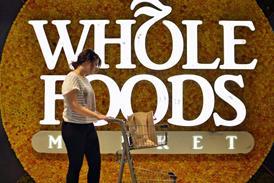Dismal results have thrust scrutiny on the failure of the Goodfella’s campaign to revive Northern Food’s frozen division. Hannah Stodell reports
It was pie in the face for Northern's chief exec Stefan Barden last week with the revelation that first-quarter sales were down 1.6% and frozen like-for-like sales had dropped a whopping 25% over the period to 3 July.
The firm attributed nearly half of the decline in frozen to its decision to axe Birds Eye pies last June and blamed its planned exit from marginal business as a contributory drag on performance. Bakery sales also suffered a 5.6% hit from a planned reduction in promotional activity during the World Cup.
These may well have been deliberate actions to boost long-term profitability but its £5m Goodfella's Pizza Fairy relaunch, dubbed a "platform for growth" and a "real step change" has also, so far, failed to turn around performance. Three months into the campaign, Panmure Gordon & Co analyst Damian McNeela questions whether the firm's frozen strategy is clear enough to be fruitful.
"Their comments about it being a competitive market and influenced by World Cup promotions notwithstanding, you would have hoped they would have seen a greater impact,"he says. "Our major concern is that the relaunch of Goodfella's pizza is not recapturing market share."
Dr Oetker, which boosted its share of the UK's £374m frozen pizza market to 40% with the acquisition of the Chicago Town brand last year, believes that Northern has lost its focus on the consumer.
"We have seen minimal product improvement," says UK marketing manager Paula Wyatt. "It is difficult to differentiate between the products and propositions in their range. There is no real connection to the above-the-line activity they have been running in-store."
IRI figures for the 52 weeks to 12 June show that Goodfella's market share is down nearly 10% (-£9.1m) bringing the value of its brand to £82.2m. Citing Kantar Worldpanel data for the year to April 2010, Wyatt says £7m has gone for good.
"We have seen completely lost sales. People are spending less on Goodfella's, dropping it and not buying into the category. We have brought initiatives to market but haven't been able to recover the hole left by the brand," she says.
Northern insists it is too early to evaluate the campaign's success and intends to deliver a progress update later this year. "It will be the second half of our financial year before we see the impact coming through," says a spokesperson.
Volumes may recover in the second half, but are investors willing to wait that long? Northern's share price has dropped 60% since Stefan Barden took the helm as chief executive in February 2007, falling from 123p to 46p at time of writing.
Barden is clear Northern will walk away from "bad" low-margin business. However, if he fails to replace that revenue with healthier returns he risks shrinking Northern's top line further.
On the plus side, Northern appears to have maintained steady, albeit pedestrian, profitability with operating profits nudging up to £54.6m for the year ending 3 April from £52.7m a year earlier and £48.4m in 2007/2008. It is pumping £26.5m into three of its Fox's biscuit factories, aimed at cutting costs and boosting earnings growth. But fears remain over Northern's pension liabilities.
Investors will be reassured that the dividend was held this year but those recently attracted to the stock will have their eye on Northern's triennial pension funding review next March as this could become unsustainable if the company is forced to pump in more cash.
So, what's the solution? Credit Suisse analysts say Northern must address share price and grasp the nettle: "Growth, acquisition or be acquired seem the only options. If the stockmarket isn't interested, then maybe private equity is?"
A real step change or stumble?
Northern hoped its Italian-American 'pizza fairy' waiter campaign could counter tough trading conditions. However, the £5m ad push has raised first half costs and analysts fear the re-launch has failed to recapture the imagination of consumers.
It was pie in the face for Northern's chief exec Stefan Barden last week with the revelation that first-quarter sales were down 1.6% and frozen like-for-like sales had dropped a whopping 25% over the period to 3 July.
The firm attributed nearly half of the decline in frozen to its decision to axe Birds Eye pies last June and blamed its planned exit from marginal business as a contributory drag on performance. Bakery sales also suffered a 5.6% hit from a planned reduction in promotional activity during the World Cup.
These may well have been deliberate actions to boost long-term profitability but its £5m Goodfella's Pizza Fairy relaunch, dubbed a "platform for growth" and a "real step change" has also, so far, failed to turn around performance. Three months into the campaign, Panmure Gordon & Co analyst Damian McNeela questions whether the firm's frozen strategy is clear enough to be fruitful.
"Their comments about it being a competitive market and influenced by World Cup promotions notwithstanding, you would have hoped they would have seen a greater impact,"he says. "Our major concern is that the relaunch of Goodfella's pizza is not recapturing market share."
Dr Oetker, which boosted its share of the UK's £374m frozen pizza market to 40% with the acquisition of the Chicago Town brand last year, believes that Northern has lost its focus on the consumer.
"We have seen minimal product improvement," says UK marketing manager Paula Wyatt. "It is difficult to differentiate between the products and propositions in their range. There is no real connection to the above-the-line activity they have been running in-store."
IRI figures for the 52 weeks to 12 June show that Goodfella's market share is down nearly 10% (-£9.1m) bringing the value of its brand to £82.2m. Citing Kantar Worldpanel data for the year to April 2010, Wyatt says £7m has gone for good.
"We have seen completely lost sales. People are spending less on Goodfella's, dropping it and not buying into the category. We have brought initiatives to market but haven't been able to recover the hole left by the brand," she says.
Northern insists it is too early to evaluate the campaign's success and intends to deliver a progress update later this year. "It will be the second half of our financial year before we see the impact coming through," says a spokesperson.
Volumes may recover in the second half, but are investors willing to wait that long? Northern's share price has dropped 60% since Stefan Barden took the helm as chief executive in February 2007, falling from 123p to 46p at time of writing.
Barden is clear Northern will walk away from "bad" low-margin business. However, if he fails to replace that revenue with healthier returns he risks shrinking Northern's top line further.
On the plus side, Northern appears to have maintained steady, albeit pedestrian, profitability with operating profits nudging up to £54.6m for the year ending 3 April from £52.7m a year earlier and £48.4m in 2007/2008. It is pumping £26.5m into three of its Fox's biscuit factories, aimed at cutting costs and boosting earnings growth. But fears remain over Northern's pension liabilities.
Investors will be reassured that the dividend was held this year but those recently attracted to the stock will have their eye on Northern's triennial pension funding review next March as this could become unsustainable if the company is forced to pump in more cash.
So, what's the solution? Credit Suisse analysts say Northern must address share price and grasp the nettle: "Growth, acquisition or be acquired seem the only options. If the stockmarket isn't interested, then maybe private equity is?"
A real step change or stumble?
Northern hoped its Italian-American 'pizza fairy' waiter campaign could counter tough trading conditions. However, the £5m ad push has raised first half costs and analysts fear the re-launch has failed to recapture the imagination of consumers.









No comments yet